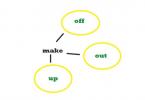Kia and Hyundai service
Why you should visit us:
Car service "Auto-Mig".
We do absolutely everything in terms of car repairs. Kia brand and Hyundai. Our employees have vast experience and a large number of satisfied clients, all work complies with the manufacturer's recommendations. In view of this, by trusting us, it is as if you are giving repairs to the manufacturer.
Our service provides high-quality services for repairing your car, offering the most reasonable prices in terms of price/quality ratio, so those who contact us never return with the problem they came with, choosing “Auto-Mig” constantly from now on. We strive to provide the best possible safety in repairing everything we undertake.
By servicing with us, you are already allowing your vehicle to last much longer without breakdowns.
"Auto-Mig" is a guarantee of reliability and stability of your car in any conditions.
It is worth noting that modern korean cars, not old copies of the Japanese, these are first-class cars of various classes, and are repaired in a special way, they already have their own history and can be repaired with high quality, using only professionally thought-out technologies.
Our auto repair center provides the following services:
- full diagnostics of the internal combustion engine, gearbox and electronics;
- diagnosing individual nodes, directions;
- repairs of any complexity;
- air conditioner maintenance (troubleshooting, refilling);
- identification of unknown breakdowns due to which other service stations refuse and subsequent elimination.
We have the most advanced equipment that helps to repair your vehicle better than anyone else, increasing the level of work done to the maximum.
We work on everything Kia models and Hyundai, please contact any of our technical centers for details.
Kia repair at AutoMig Auto Service Center
(examples of completed work):
Hyundai repair at Auto-Mig Auto Service Center
(examples of completed work):
Repair of commercial vehicles in our technical center:
Many Korean cars are used by companies - these are small Porter and Bongo trucks. And for passenger transportation, usually Starex H-1 and Carnival. For these fleets, we also offer our friendly approach and maximum attention.
- We work on a cashless basis
- We conclude contracts
- We provide everything Required documents For accounting
Commercial vehicle servicing
(examples of completed work):
Checking the car before purchasing
- We will help you buy a car without any pitfalls. Checking the machine before purchasing will ensure compliance with technical conditions declared by the seller.
And just a little more about our technical center:
Our specialists will perform engine and suspension repairs of almost any degree of complexity. We use official electronic catalogs and we strictly follow the repair technology. When conducting repair work we use spare parts only famous manufacturers, which we purchase directly from importers, which ensures their low cost.
At the AutoMig service center you can repair braking system Your Kia or Hyundai using high-quality materials and manufacturer technology.
Come, we will be happy to help you!

Complexity
Lift1 - 3 h
Tools:
- L-shaped socket wrench 12 mm
- Mounting blade
- Calipers
Parts and consumables:
- Marker
- Mandrel for centering the driven disk
- Refractory Grease
The main malfunctions that require removal and disassembly of the clutch to eliminate are:
- Increased (compared to usual) noise when disengaging the clutch;
- jerking when the clutch operates;
- incomplete engagement of the clutch (clutch slips);
- incomplete disengagement of the clutch (the clutch “drives”).
Note:
If the clutch fails, we recommend replacing all its elements at the same time (driven and pressure disks, clutch release bearing), since replacing the clutch is labor-intensive, and intact clutch elements have already reduced their service life, so if they are installed again, repeated removal/installation may be required clutch after a relatively short mileage.
1. Remove the gearbox as described.
Note:
If the old pressure plate is installed, you should mark in any way (for example, with a marker) the relative position of the disc housing and the flywheel in order to install the pressure plate in its original position (to maintain balance).
2. While holding the flywheel with a mounting spudger (or a large screwdriver) from turning, remove the six bolts securing the clutch pressure plate housing to the flywheel. Loosen the tightening of the bolts evenly: each bolt two turns of the wrench, moving from bolt to bolt along the diameter.

Note:
The photo shows the fastenings of the clutch pressure plate housing.

3. Remove the clutch pressure and driven discs from the flywheel, holding the driven disc.

4. Inspect the clutch driven disc. Cracks on the parts of the driven disk are not allowed.

Note:
The driven disk consists of two annular friction linings, which are mounted on the disk hub through damper springs. If the driven disc linings are oily, the cause may be wear on the gearbox input shaft oil seal. It may need to be replaced.
5. Check the degree of wear of the friction linings of the driven disc. If the rivet heads are recessed by less than 1.4 mm, the surface of the friction linings is oily, or the rivet joints are loose, then the driven disk must be replaced.

6. Check the secure fit of the damper springs in the driven disk hub sockets by trying to move them in the hub sockets by hand. If the springs move easily in their seats or are broken, replace the disc.

7. Check the runout of the driven disk, if visual inspection its warping was detected. If the runout is greater than 0.5 mm, replace the disc.

8. Inspect the working friction surfaces of the flywheel, paying attention to the absence of deep marks, scuffs, nicks, obvious signs of wear and overheating. Replace defective components.

9. Inspect the working surfaces of the pressure plate, paying attention to the absence of deep marks, scuffs, nicks, obvious signs of wear and overheating. Replace defective components.

10. If the rivet connections of the casing parts and the pressure plate become loose, replace the pressure plate assembly.

11. Using an external inspection, evaluate the condition of the pressure plate diaphragm spring. Cracks on the diaphragm spring are not allowed. The places highlighted in the photo are the contacts of the spring petals with the clutch release bearing that must be in the same plane and have no obvious signs of wear (wear should not be more than 0.8 mm). Otherwise, replace the pressure plate assembly.

12. Inspect the connecting links of the casing and disk. If the links are deformed or broken, replace the pressure plate assembly.



15. Before installing the clutch, check that the driven disk moves easily along the splines of the transmission input shaft. If necessary, eliminate the causes of jamming or replace defective parts.

16. Apply refractory grease to the drive hub splines.

17. When installing the clutch, first install the driven disc using a mandrel.

18. Then install the pressure plate housing, aligning the marks made before removal, and screw in the bolts securing the pressure plate to the flywheel.

Note:
Install the driven disc so that the protruding part of the disc hub is directed towards the clutch housing diaphragm spring.
19. Screw in the bolts evenly, one turn of the wrench each, in the sequence shown in the photo.

20. Remove the mandrel and install the gearbox as described.
21. Check clutch operation as described.
The article is missing:
- Photo of the instrument
- Photos of parts and consumables
- High-quality photos of repairs
The new clutch has minimal wear This is why it takes a little effort to press the pedal. Over time, the disc wears out (the friction linings become thinner), the petals move to the side, and accordingly, the fork changes its position. When you press the clutch pedal, you have to apply more force.
Before changing the clutch on a Solaris, make sure that this particular unit has failed. The first sign that you need to prepare for repairs is difficulty when shifting gears. Also pay attention to the following symptoms:
- the clutch pedal began to be pressed with great force;
- “grabbing” the clutch began at the very bottom;
- when shifting 3rd or 5th gear the clutch moves;
- There is a jerking noise when changing gears.
Therefore, before purchasing a kit and starting to replace the Solaris clutch, make sure that all components are in full working order and that there is no airing hydraulic system. If a suspicious crunching noise occurs when shifting gears, you may need to replace the master or slave cylinder.
A separate case is when slipping occurs during shifting due to oil getting on the clutch disc. Signs of this problem may include:
- traces of oil in the lower part in the area of the connection between the gearbox and engine;
- increased engine oil consumption.
The reason for this may be a faulty gearbox. Due to the destruction of the input shaft oil seal, oil from the engine gets inside the box, where the disc becomes oiled. In this case, before changing the clutch, it is necessary to repair the gearbox.
Design features
Knowing that the factory-installed Solaris clutch resource is relatively short, the manufacturer modern models uses an improved design. When purchasing a new set, give preference to the original production parts, on which a basket with 18 petals is installed. The factory configuration most often contains a part with 12 petals. Also replace the entire kit, which includes:
- clutch disc;
- clutch basket;
- release bearing;
- clutch fork.
Replacing the clutch on a Solaris with your own hands requires time, as well as a large amount of dismantling work associated with disassembling the chassis. Some electrical equipment will need to be replaced. If necessary, with the installation of a new clutch, you can carry out preventive work on the starter and elements of the running gear consumables. It would be logical to change the oil in the gearbox.
Preliminary work

Before starting disassembly, place the vehicle on inspection hole or a lift. Block rear wheels and remove the battery. Then remove the protection from the bottom of the engine and remove both front wheels. Drain the gearbox oil. If the car is mounted on a jack, provide the possibility of jacking up the engine.
- Remove the ECU.
- Disconnect the battery cradle.
- Remove the box with air filter and pipes.
- Remove the starter.
- Disconnect from the gearbox all elements that interfere with its dismantling.
- Remove the front wheel drives.
- Disconnect the ends of the gear shift and gear selection cables from the gear shift levers.
- Disconnect the electrical connector for reverse gear.
- Remove the speed sensor from the gearbox.
- Remove the working cylinder and hydraulic pipeline.
- Unscrew the bolt holding the ground wire.
- Remove the heat shield internal hinge right wheel drive.
Securely support the engine by jacking it up from below. - Remove the left engine mount connected to the gearbox housing.
- Disconnect the gearbox from the engine cylinder block.
- Loosen the 4 bolts connecting the gearbox and engine sump.
Move the gearbox away from the engine so that input shaft came out of the clutch driven disc hub.
Installing a new element
To replace the clutch on a Hyundai Solaris, you must first dismantle the faulty unit. To do this you need to perform simple operations.
- Unscrew the 6 x 12 bolts connecting the flywheel to the clutch basket.
Ensure stillness crankshaft. To do this, use a lever that inserts into the gap between the flywheel teeth. Place it on the bolt inserted into one of the holes in the engine oil pan.
- Remove the clutch pressure and driven discs.
- Make sure that the pins located on the flywheel are aligned with the holes in the clutch basket.
- Install the new driven and pressure plates in reverse order, paying attention to the sides. To do this, use a centering mandrel of the appropriate diameter.
- Insert the shank of the mandrel into the hole in the crankshaft flange.
- Tighten the bolts. Tighten the opposite bolts one turn in a circle.
- Finally tighten the bolts to the required torque.
- Remove the centering attachment.
When replacing the clutch, it is rational to install a new release bearing. Even if it is in working order and there are no signs of wear. This completes the replacement of the clutch on the Hyundai Solaris. Assemble the parts and assemblies in the reverse order, observing the tightening torques of the bolts and nuts recommended by the manufacturer.
Sometimes Hyundai owners Solaris are faced with clutch problems and are therefore looking for a reliable car service to check the functionality of this system and assess the condition of the hydraulics.
GAG-AUTO specialists are ready to help you!
In some cases, the situation is corrected by simply bleeding the system, during which the air trapped in it is removed. In cases of wear of an individual part, replacing the clutch disc helps, release bearing or baskets. However, the scope of work performed is similar to a complete replacement of the entire clutch system.

To avoid clutch problems, GAG-AUTO technicians recommend observing the following conditions:
- Purchase and Hyundai Solaris clutch replacement must be produced in one place in order to avoid shifting responsibility to “cheap non-original spare parts” or “crooked” mechanics.
- If your car has a dual-mass flywheel, Solaris clutch replacement may not be required; Sometimes just changing the flywheel is sufficient.
- IN mandatory Check the operation of the dual-mass flywheel periodically! His incorrect work can lead to disastrous results, including engine splitting.
- The clutch pedal should be depressed as quickly as possible, and released, on the contrary, slowly and smoothly.

If you couldn’t avoid the problem and you need to replace the Solaris clutch, the price of such a service at GAG-AUTO is quite affordable. Our specialists, having significant experience in such operations, will perform it professionally and in short term.
Call, come. We will help you fix the problem quickly, efficiently and inexpensively.
I think that this article will come in handy for those Hyundai Solaris drivers who are puzzled by replacing a slipping car. If you have this problem and can't find the reason, I hope this helps you. I once noticed that in third and fifth gears the car did not pick up speed, but only increased its speed. This was especially felt in winter period. At that time the car had covered about 35 thousand kilometers. I have already gone to the MOT. But I did not immediately receive a clear answer.
I couldn’t just leave this matter alone and let it take its course, after all, this is my favorite car, and I have only one life) I thought that this slippage was due to snow accumulation on the roads. But a friend told me that this happened to her in the summer too and she laid it all out for me. It turns out that it was necessary to change to a Hyundai Solaris. Between the two of us we had three ideas on this matter:
The oil seal drips, oil flows onto it, and it, accordingly, slips;
Not fully pressed by the basket.
I asked my brother to crawl under. He told me that he was seeing oil stains near the clutch and an already dried stain on the bottom of the guard.
I had to immediately go to the service center, having previously purchased a clutch for a Hyundai Solaris in a store where I am a regular customer. The store told me that there are two types of clutches for Solaris:
1) 136 (which is in stock)
41421-32000 — release bearing
41300-23136 — clutch basket
41100-23136 — clutch
In order to save money, we decided to change the clutch on the Solaris ourselves. My brother said that it was necessary to buy a hitch, since the oil was being poured from the engine. I went to get a hitch, and at the same time bought an oil seal. When he dismantled the car and got to the hitch, this is the picture that opened up to our eyes. The clutch was throwing oil around a lot. was already black, starting to crumble a little, because... the rivets simply flew off. I probably took too long. You are the one to blame. Made it to this extent. It was necessary to find out the cause at the very first sign of a malfunction. And now the seal was leaking, and the clutch was just floating in oil. Which, of course, is unacceptable. Along with the whole canoe, we also had to change the oil seal. Don’t forget to buy more oil, because two liters leaked out ((

(photo stolen from here http://www.drive2.ru/l/1480445/)
In short, I washed it, cleaned it practically until it shined) just kidding. The clutch is scrapped, except for the bearing, of course. Although he is normal, still better as a set replace everything. To avoid such mischief, you should remind about warranty periods. The Hyundai Solaris oil seal has a 1 year warranty, i.e. 20 thousand kilometers. And I drove about 30. Although the operation of Solaris was very gentle. Therefore, an earnest request to all Solaris owners: do not pull the tires if the clutch slips. You can look under it yourself and check if there are any leaks. If your Solaris has only driven 20 thousand km, then the OD can do the repairs for free, you just need to get it repaired.



